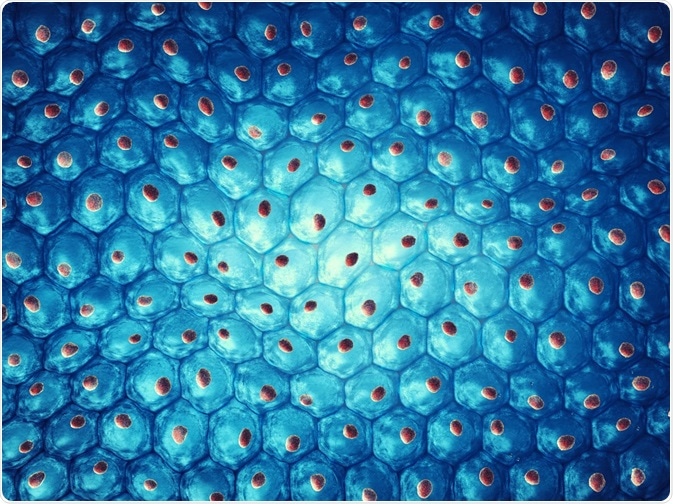Cell reprogramming is the process used for converting cells from one particular type to another. Over the past six decades, many techniques have been developed to define induced pluripotency.

Credit: nobeastsofierce/ Shutterstock.com
Some of the principles and techniques that have been developed in cell reprogramming research are the application of somatic cell nuclear transfer in cell differentiation, which has confirmed the fact that the differentiated cell and early embryonic cell contains similar genetic information; approaches that are useful in culturing and generating pluripotent cells; and the conclusion that transcription factors are mainly responsible for deciding the cell fate.
Various stages of development of cell programming research are discussed below:
Primary developmental stage
- In 1885: August Weissmann suggested that the genetic material subsets became isolated between the daughter cells simultaneously with the progress of the development of cell reprogramming research.
- In 1888: Wilhelm Roux dissipated one of the two cells of an embryo. He found that only half of the complete embryo is developed from the resultant embryonic cell. Hans Spemann had succeeded in applying this method using the newt embryo in 1935.
- In 1909: Ethel Browne Harvey, who conducted much research on cell division in the embryo of sea urchins, was the first to discover that secondary axis can be induced into the embryo host by cell transplants. Invention of Spemann’s organizer is based on Harvey’s work on embryonic cell division.
- In 1928: Hilde Mangold and Hans Spemann conducted various experiments with the embryo of Salamanders to determine the factors that are responsible for embryonic differentiation and determination. These experiments led to the demonstration of cell-to-cell induction, by which fate of the cells undergoing differentiation can be decided in the embryonic stage.
The cells responsible for embryonic differentiation and determination are called as the Spemann organizer. Subsequently, Spemann organizer formed the base to various molecular embryonic researches that are conducted to find the factors that are responsible for deciding the fate of the cell.
In addition, Spemann had conducted various studies to find whether the cells that are subjected to differentiation can be restored back to embryonic state or these cells persist to remain in a differentiated state. Spemann presented that the transplanted nucleus contained a genome that has the ability to direct all types of cell differentiation, if a nucleus of the specialized cell is implanted into an already enucleated egg that had developed into an embryo.
Secondary developmental stage
- In 1962: John Gurgeon is the first person to practically define the cell reprogramming technique in 1962. His research on cloning of frogs through nuclear transfer led to the initiation of nuclear reprogramming of the cells. Nuclear reprogramming is a process by which gene expression of a cell type is converted into the gene expression of the other cell types.
- In 1981: Gail Martin and Martin Evans initiated and developed the mouse embryonic stem cells. Austin Smith presented necessary conditions for embryonic stem cell culture and factors that are responsible for pluripotency in 1988.
- In 1987: Factor-mediated cell fate conversion was the second stage in this research line, which was established by Harold Weintraub. His research indicated the possibility of conversion of fibro blasts into muscle lineage through MyoD transduction.
- In 1997: For the first time, lan Wilmut cloned a sheep, which was a milestone in the history of cell reprogramming research.
- In 1998: Application of cell reprogramming approach in the discovery of HIV-TAT.
- In 2001: Stem cells of an embryo were used in reprogramming somatic stem cells. These reprogrammed cells and pluripotent cells are found to have same properties. It has been observed that the heterokaryons experienced transcriptional changes in the absence of nuclear hybridization.
- In 2007: The history of research over cell reprogramming had led to the development of induced pluripotent stem cells. Yamanaka and James Thomson generated human induced pluripotent stem cells for the first time.
- In 2012: John Gurdon and Shinya Yamanaka had succeeded in conducting research, in which the mature cell subjected to differentiation is converted into an immature cell and this immature cell can be developed into any cell in the body. This invention was a major breakthrough in the history of cell reprogramming research.
Recent developments
Over recent years, induced pluripotent stem cells that are generated from somatic stem cells have been widely used in regenerative medicine. Nonetheless, the efficiency of cell reprogramming remains low. There are some other factors such as tumorigenic potential, instability, etc., which affect the use of induced pluripotent stem cells, particularly in clinical applications.
Hence, the reprogramming technique is under the developmental stage in order to generate induced pluripotent stem cells of better efficiency, quality, and safety. The development generally targets the source of somatic cell, reprogramming factor cocktail, the technique by which reprogramming factors are introduced, and conditions are cultured to maintain the generated induced pluripotent stem cells.
Further Reading